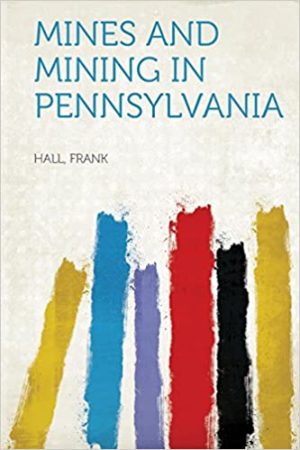
Mines and Mining in Pennsylvania by Frank Hall
 Mines and Mining in Pennyslvania by Frank Hall
Mines and Mining in Pennyslvania by Frank Hall Published by W. S. Ray (1904)
Format: eBook, 24 pp
Topics: Social History, Mining Industry
Get your own copy from: Archive.org
Written by the assistant chief in the Department of Mines, this is a short booklet about the then-current state of the mining industry in Pennsylvania. Starts off a little effervescent about coal as a magical resource, which I suppose is understandable given the circumstances.
According to the booklet, PA has the greatest depository of coal in the US and has more capital invested in coal operations than any other state. There are two types of coal present: anthracite in the eastern part of PA, and bituminous in the western part. There’s about 3x more bituminous coal available in PA compared to anthracite, but anthracite is more valuable due to its higher percentage of carbon (burns hotter, cleaner, and good for both business and personal use).
It was not always obvious that anthracite coal was useful or desirable. Apparently it requires a special/different method of burning than other types of coal, and this method is not obvious. An amusing story about Colonel George Shoemaker is included; he tried to introduce anthracite to the people of Philadelphia in 1812, and they had him arrested as a swindler. Some time later the Philadelphians accidentally figured the secret of burning anthracite (Let It Alone) and fell in love with it.
Bituminous coal has been mined in PA since the early 1700s, but not seriously used in commerce until the late 1700s when the introduction of steam tow-boats made transportation faster, cheaper, and easier. Herein the booklet goes on to describe the introduction of various canals, steam railways, and other ways that coal is transported out of the state. Bituminous coal was primarily sent down the Ohio River, then onto the Pennsylvania Railroad, Ohio Railroad, and Baltimore Railroad.
Estimates are given to the amount of coal produced, how much it’s worth, and how much is LEFT to be mined. In 1903, 105,000,000 tons of bituminous coal was produced at a value of $275,000,000. Today that’d be worth over $7 BILLION.
In 1903, PA was producing coal worth more than the entire total value of all the copper, gold, and silver mined in the US at the same time. Furthermore, PA produced half of all the coal produced in the entire United States.
As for longevity, the anthracite coal fields were estimated to have enough left to last another 89-109 years, if kept going at the same output. Since the booklet was written in 1903/1904, that’d put the end of the fields at about 1993-2013. Of course, nowadays there isn’t as much of a demand for coal as there was 100+ years ago, so production has slowed (as of the 1960s) and a lesser amount of mining continues onward into the 2020s.
(There are no estimates for the bituminous coal fields’ longevity.)
I find this next part particularly interesting because it involves the daily life of miners: their wages and living conditions.
According to this booklet, miners were paid about $2.50/day in 1903. That’d be about $65/day in today’s money, or $8.12/hour. The current minimum wage in PA is $7.25; the average coal worker makes about $16/hour (I think), so that’s a pretty good salary increase from what workers were making during the coal boom.
Anthracite mining required many more people (“slate pickers, track layers, pump runners, foot and slope men, drivers, door-boys, engineers, firemen, blacksmiths, carpenters, loaders and plate men” (page 9)) and needed more prep for the market compared to bituminous coal, but it was worth much more. All these workers needed somewhere to live– they lived in villages close to the mines, and their children went to schools provided by the mining company. The booklet doesn’t go into too much detail about what these town actually looked like, or how they functioned.
As for the business side of things: the railroad companies were buying up the land that the anthracite coal mines were on, and were starting to merge and become more centralized. The booklet says: “it will be but a very short time, if, indeed, it is not already an established fact, until one gigantic syndicate will control absolutely the destiny of the anthracite coal trade and with it indirectly the destiny of thousands of industries and countless thousands of human beings” (page 8). I’m pretty sure this is exactly what happened, though I’m not as up on my railroad history as I’d like to be.
And then it ends again with some more gushing about how wonderful coal is.
All in all, a very well-written booklet about the state of mining in Pennsylvania, very easy to understand even for people who don’t care about coal mining. Not sure if it was aimed at getting more businesses over to PA, or just for the general public, but it’s one of the least-technical coal mining books I’ve found from that time that’s still informative.
For the genealogist, it has good starting information on what the coal industry was like at the turn of the last century, including hints of what it was like to work in a coal mine and live in a coal mining town.
My own ancestors lived in coal mining towns until about the 1930s. I’ll add more info to this page when I have something written up.
Notes
- Multiple blank pages in the back, so really only about 9 pages worth of text.

